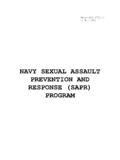Transcription of Preventing Sexual © The Author(s) 2011 Aggression …
1 Et Against Women1 Ohio University, Athens, OH, USA2 Brown University, Providence, RI, USA3 Independent Consultant, Mount Shasta, CA, USA and Department of the NavyCorresponding Author:Christine A. Gidycz, Department of Psychology, Ohio University, 200 Porter Hall, Athens, OH 45701, USA Email: Sexual Aggression Among College Men: An Evaluation of a Social Norms and Bystander Intervention ProgramChristine A. Gidycz1, Lindsay M. Orchowski1,2,and Alan D. Berkowitz3 AbstractMen and women living in randomly selected 1st-year dormitories participated in tailored single-sex Sexual assault prevention or risk-reduction programs, respectively.
2 An evaluation of the men s project is presented (N = 635). The program incorporated social norms and bystander intervention education and had an impact on self-reported Sexual Aggression and an effect on men s perceptions that their peers would intervene when they encountered inappropriate behavior in others. Relative to the control group, participants also reported less reinforcement for engaging in sexually aggressive behavior, reported fewer associations with sexually aggressive peers, and indicated less exposure to sexually explicit evaluation, Sexual Aggression , Sexual assault preventionSexual assault is pervasive on college campuses across the United States, with large-scale surveys of college women indicating that approximately 12% have experienced a rape (Kilpatrick, Resnick, Ruggiero, Conoscenti, & McCauley, 2007).
3 Between 11% and ArticleViolence Against Women17(6) 720 742 The Author(s) 2011 Reprints and permission: http://www. : ://. et al. 72128% of college women have been sexually assaulted over brief 2-to-3-month intervals (Gidycz, Orchowski, King, & Rich, 2008; Rich, Gidycz, Warkentin, Loh, & Weiland, 2005; Turchik, Probst, Chau, Nigoff, & Gidycz, 2007). Estimates of Sexual assault per-petration garnered from men are substantially lower than those provided by women; however, the extent of men s self-reported Sexual Aggression is also alarming (Gidycz, Warkentin, Orchowski, & Edwards, 2011).
4 College men s self-reported perpetration of sexually aggressive (SA) acts suggest incidence rates between 10% (Gidycz, Warkentin, & Orchowski, 2007) and 17% (Loh, Gidycz, Lobo, & Luthra, 2005) over a 3-month period and approximately 35% over a 4-year period (White & Smith, 2004). Given that a very small group of men commit the majority of these assaults (Lisak & Miller, 2002), it is crucial that prevention efforts take into account the fact that a majority of assaults are perpetrated by a minority of federal mandates to provide prevention programming on college campuses (National Association of Student Personnel Administrators, 1994), there remains a dearth of program outcome evaluations demonstrating the effectiveness of Sexual violence pre-vention efforts.
5 Experts have highlighted the need for sound theories to guide program-ming efforts (see Gidycz, Orchowski, & Edwards, 2011) with recommendations that programs target single-gender audiences. The program goals for men s and women s pro-gramming do not overlap (Gidycz, Rich, & Marioni, 2002) and fears of embarrassment make it difficult for men to openly discuss their attitudes with women present (Berkowitz, 1992, 1994). Yet the vast majority of published outcome evaluations report on mixed-gender programs (for reviews, see Anderson & Whiston, 2005; Morrison, Hardison, Mathew, & O Neil, 2004).
6 In response to these critiques, researchers have developed and evaluated programs geared toward single-gender audiences (Gidycz, Warkentin, et al., 2011). Programs that target the behavior of potential perpetrators ( , men) are described as rape- prevention programs, and programs geared toward reducing a woman s risk for victimization are described as risk-reduction programs (Lonsway et al., 2009). More recently, bystander interventions have been implemented with single-gender groups, based on the premise that all members of a community are affected by violence and, therefore, must be involved in dispelling the social norms that perpetuate violence against women (Edwards, Jumper-Thurman, Plested, Oetting, & Swanson, 2000).
7 Bystander approaches teach individuals skills to take action and to intervene when witnessing risky peer behavior (Banyard, Plante, & Moynihan, 2004), and are appropriate for male audiences, given that most men do not perpetrate but are in a position to prevent perpetrations committed by the minority of , there are some limited data to support the effectiveness of Sexual assault prevention , risk reduction, and bystander intervention programs (for reviews, see Gidycz Orchowski et al., 2011; Lonsway et al., 2009; Orchowski, Gidycz, & Murphy, 2010).
8 prevention programs account for only 8% of programs and demonstrate modest success in terms of attitude change regarding rape ( , Morrison et al., 2004). Evaluations of risk-reduction programs present mixed findings, with some data demonstrating decreases in victimization and revictimization (Gidycz et al., 2001; Orchowski, Gidycz, & Raffle, 2008), increases in self-protective behaviors (Gidycz, Rich, Orchowski, King, & Miller, 722 Violence Against Women 17(6)2006; Orchowski et al., 2008), resistance self-efficacy, and assertive Sexual communication (Orchowski et al.)
9 , 2008). Bystander interventions have also shown promise as a potentially effective intervention. For example, a program by Banyard, Moynihan, and Plante (2007) was effective in decreasing rape myths and increasing Sexual assault knowledge, prosocial bystander attitudes, and confidence in intervening in a threatening situation. Program par-ticipants were also more likely than the control group to engage in prosocial bystander behavior over a 2-month follow-up. Despite all of the above, it has been concluded that programming efforts have generally not been successful in reducing Sexual violence on college campuses (Lonsway et al.
10 , 2009). The lack of program effectiveness is not surpris-ing, given that programs are often brief and, with few exceptions (see Foubert & Perry, 2007; Gidycz et al., 2006; Orchowski et al., 2008), evaluations have not addressed program impact on rates of self-reported victimization or perpetration. Previous studies have also been limited by nonrandom assignment of participants to program and control groups, small sample sizes, and short follow-up assessment intervals (Gidycz et al., 2002).In light of these limitations, it is necessary to improve the development of individual-level prevention and risk-reduction programs (Gidycz, Orchowski, et al.











